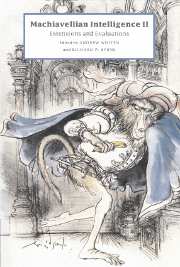Book contents
- Frontmatter
- Contents
- Contributors
- Preface
- 1 Machiavellian intelligence
- 2 Friendships, alliances, reciprocity and repair
- 3 Why Machiavellian intelligence may not be Machiavellian
- 4 Social intelligence and success: Don't be too clever in order to be smart
- 5 Minding the behaviour of deception
- 6 The Machiavellian mindreader
- 7 Exploiting the expertise of others
- 8 Primates' knowledge of their natural habitat: As indicated in foraging
- 9 Evolution of the social brain
- 10 The modulatory of social intelligence
- 11 The Technical Intelligence hypothesis: An additional evolutionary stimulus to intelligence?
- 12 Protean primates: The evolution of adaptive unpredictability in competition and courtship
- 13 Egalitarian behaviour and the evolution of political intelligence
- 14 Social intelligence and language: Another Rubicon
- Index
3 - Why Machiavellian intelligence may not be Machiavellian
Published online by Cambridge University Press: 23 November 2009
- Frontmatter
- Contents
- Contributors
- Preface
- 1 Machiavellian intelligence
- 2 Friendships, alliances, reciprocity and repair
- 3 Why Machiavellian intelligence may not be Machiavellian
- 4 Social intelligence and success: Don't be too clever in order to be smart
- 5 Minding the behaviour of deception
- 6 The Machiavellian mindreader
- 7 Exploiting the expertise of others
- 8 Primates' knowledge of their natural habitat: As indicated in foraging
- 9 Evolution of the social brain
- 10 The modulatory of social intelligence
- 11 The Technical Intelligence hypothesis: An additional evolutionary stimulus to intelligence?
- 12 Protean primates: The evolution of adaptive unpredictability in competition and courtship
- 13 Egalitarian behaviour and the evolution of political intelligence
- 14 Social intelligence and language: Another Rubicon
- Index
Summary
Introduction
The discovery of primate social complexity during the last 20 years stimulated a reinterpretation of the nature and evolution of primate intelligence. In this chapter we attempt to do three things. Firstly we present a short background highlighting some inherent difficulties with the current ‘social complexity/cognition’ model from which the Machiavellian Intelligence hypothesis derives. Next we explore the consequences of these problematic issues with data on sexual consorts in baboons. Finally we present another way to frame the social complexity/cognition link that we feel has the potential to more fully explain our consort data and to resolve some of the inherent ambiguities in the social complexity model of intelligence. In the process we are left to wonder whether Machiavellian intelligence is really ‘Machiavellian’.
The model
The intellectual events that culminated in the Machiavellian Intelligence hypothesis look slightly different from the description offered by Byrne and Whiten (Chapter 1) when seen from the perspective of primate field studies (Strum & Fedigan, 1997). This vantage point may help to explain why the Chance–Jolly–Kummer—Humphrey (Chance & Mead, 1953; Jolly, 1966; Kummer, 1967; Humphrey, 1976) hypotheses about ‘social intelligence’ did not actually begin to constitute a ‘domain’ of knowledge and research for nearly 20 years. Field data and shifts in theoretical orientations were crucial. Long-term studies of chimpanzees (see Goodall, 1986 and references therein) and baboons (Altmann, 1980; Ransom, 1981; Strum, 1981; Stein, 1984), in particular, documented an array of social relationships. These were initially treated as mere ‘social noise‘ resulting from many social animals living together (e.g. Ransom & Ransom, 1971; Ransom, 1981; Goodall 1986).
- Type
- Chapter
- Information
- Machiavellian Intelligence IIExtensions and Evaluations, pp. 50 - 85Publisher: Cambridge University PressPrint publication year: 1997
- 17
- Cited by



